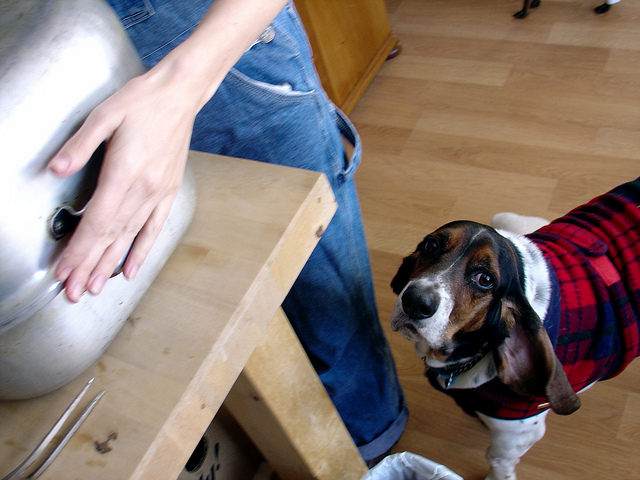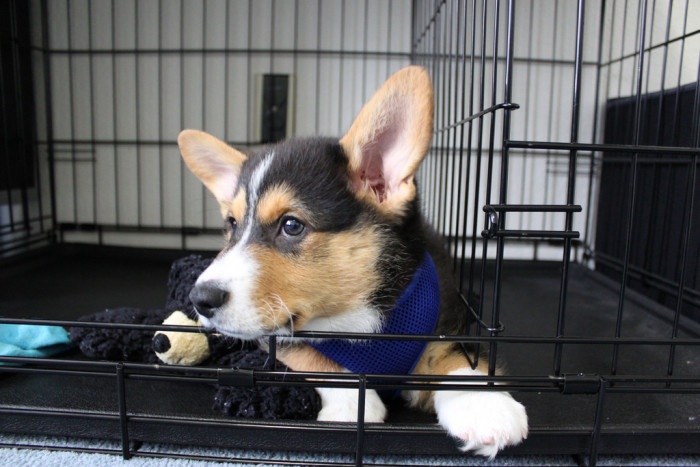Meal time can feel like you are feeding wild animals. Your calm, docile house dog can go from zero to sixty before you blink. All of a sudden you have a frenzied, barking, jumping, biting dog that knocks the food out of your hand before you can even get on the ground.
But it doesn’t have to be that way. Meal time is a great opportunity to work on your dog’s self-control and manners every day. Here are some tips to help get you started.
Break it Down
If you dog has multiple bad behaviors, you are going to need to break it down and work on one at a time in order to help your dog be successful. I have shelties, so barking is, of course, a big one. So I started with barking. If your dog is doing some more dangerous, like biting, you should address that behavior first.
Most dogs know when meal time is. They know by the time of day and what you are doing. As soon as your dog starts the behavior you are working on extinguishing, “meal time” stops. We will use barking as an example.
- You get up and go to the area where your dog’s food is and he starts barking before you reach it.
- Turn around, go back to what you were doing and ignore your dog until he stops barking.
- After a few seconds of silence, head back toward the food area.
- If he barks again, return again and wait for a few seconds of silence.
- If you get to where you have poured his food and that’s when he breaks down and starts barking, just set the bowl out of reach and go back to what you were doing, ignoring him until he stops barking.
- Repeat until you can get your dog’s food and give it to him in complete silence.

This is going to take time! Also, during this time, your dog may be doing other behaviors you do not like – jumping, tripping you because he is under your feet, etc. – we will address those one at a time. A barking dog is usually over threshold and won’t be able to learn to do anything else, so we are addressing that first.
Extinction Burst
Dogs go through something called an “extinction burst.” This means they are going to try something harder, longer, etc., before they realize it’s not working and quit. SO expect the barking to get worse before it gets better.
Next Step
The next step is to decide what you would like your dog to do instead. If you don’t mind that he follows you around, as long as he is not jumping and barking, then you would follow the above steps to get rid of the jumping now that the barking is gone.

Establish Criteria
If you want your dog to do something specific, for example sit and wait for his dinner instead of follow you, now is the time to work on that – after you have him calm (no more barking and jumping) enough to actually listen and work with you.
You can train this just like you would a sit and stay, the reward being his meal when he is released.
Multiple Dogs
If you have multiple dogs, like I do, there are several ways to make meal time easier. The best is crates. If each dog is crate trained and has a “designated crate” you can teach them to run in and wait in their own crate for their meal. I find that most dogs learn the running into their crate on their own. If you consistently feed them in their crate – creatures of habit that they are – they will start running into their crate on their own. (Of course, you can do this training a single dog too!)
Getting the stay
Work with each dog separately at first.
Then, you need to get them to stay in the crate. Have your criteria decided, is in the crate enough? Or do you want them to down in their crate or sit?
If you want a specific behavior, you will have to work on that first before the stay. Once your dog is running into the crate and doing the desired behavior (stand, sit, down) you are ready for the stay.
- Practice bringing out the meal (work each dog individually still).
- If your dog leaves his crate, take the bowl and leave the area, just like you did above when your dog barked or jumped.
- When he returns to his crate and stays, bring the bowl back. If he gets out, take the bowl and leave again.
- Repeat until you can get all the way to the crate, give your dog his bowl, and close the door.

Key to Success
Consistency is the key to all of this. If you have multiple family members feeding the dog(s), make sure they are all aware of the new protocol and are willing and able to follow it precisely. Otherwise your dog will just get confused and his bad behavior may get worse.
About the Author
Based in Wilsonville, Ore., animal lover Kristina N. Lotz is a Certified Professional Dog Trainer – Knowledge Assessed (CPDT-KA). She is the founder of A Fairytail House. In her spare time, she trains and competes in herding, agility, obedience, rally, and conformation with her Shetland Sheepdogs. She smartly married a Veterinary Technician, who helps keep the fur kids happy and healthy, and provides a quick resource for articles.

